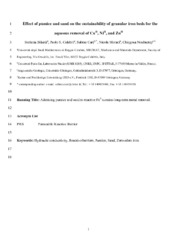Effect of pumice and sand on the sustainability of granular iron beds for the aqueous removal of CuII, NiII, and ZnII
Preprint2013
DOI: https://doi.org/10.1002/clen.201100472
Persistent URL: http://resolver.sub.uni-goettingen.de/purl?gldocs-11858/6759
Persistent URL: http://resolver.sub.uni-goettingen.de/purl?gldocs-11858/6759
Bilardi, Stefania; Calabrò, Paolo S.; Caré, Sabine; Moraci, Nicola; Noubactep, Chicgoua, 2013: Effect of pumice and sand on the sustainability of granular iron beds for the aqueous removal of CuII, NiII, and ZnII. In: Bilardi, Stefania; Calabrò, Paolo S.; Caré, Sabine; Moraci, Nicola; Noubactep, Chicgoua (2013): Effect of pumice and sand on the sustainability of granular iron beds for the aqueous removal of CuII, NiII, and ZnII, DOI: 10.1002/clen.201100472.
 |
Dokument öffnen: |
Current knowledge of the basic principles underlying the design of Fe0 beds is weak. The volumetric expansive nature of iron corrosion was identified as the major factor determining the sustainability of Fe0 beds. This work attempts to systematically verify developed concepts. Pumice and sand were admixed to 200 g of Fe0 in column studies (50:50 volumetric proportion). Reference systems containing 100 % of each material have been also investigated. The mean grain size of the used materials (in mm) were 0.28 (sand), 0.30 (pumice) and 0.50 (Fe0). The five studied systems were characterized (i) by the time dependent evolution of their hydraulic conductivity (permeability) and (ii) for their efficiency for aqueous removal of CuII, NiII, and ZnII (about 0.30 M of each). Results showed unequivocally that (i) quantitative contaminant removal was coupled to the presence of Fe0, (ii) additive admixture lengthened the service life of Fe0 beds, and (iii) pumice was the best admixing agent for sustaining permeability while the Fe0/sand column was the most efficient for contaminant removal. The evolution of the permeability was well-fitted by the approach that the inflowing solution contained dissolved O2. The achieved results are regarded as starting point for a systematic research to optimise/support Fe0 filter design.
Statistik:
ZugriffsstatistikSammlung:
- Geologie [933]

